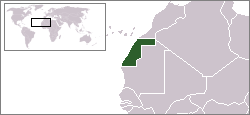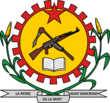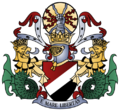Western Sahara
“Where?”
– you on Western Sahara.
| |||
| Official language | Arabic, Jawa, (Swedish, transvestites only) | ||
| Largest city | Al `Uyūn (العيون) | ||
| Area - Total - % water |
266,000 km² Nonexistent | ||
| Population - Total - Density |
1.5 people (A guy once claimed citizenship here but mistook it for Western Australia), 400 camels, 7 transvestites (see Politics) 0.000001/km² | ||
| Status is disputed |
Spain buggered off in 1975. Mostly administrated by Morocco as its south bit, disputed with the Polish front which proclaimed the Sandy Arab Democratic Republic on February 27, 1976, UN is administrating the rest. Thankfully, the whole damned territory is make-believe and no-one cares. | ||
| Currency | Moroccan Dirham (MAD) | ||
| Time zone | +0 | ||
| Calling Code | + 212 (same code as Morocco) | ||
| ISO 3166-1 alpha-2 code | I won't pretend, even pretend I know wtf that means | ||
Western Sahara (Arabic: الصحراء الغربية; : al-arā' al-Gharbīyah) is the second most pointless place on earth, just behind North Dakota, but is the Shinning Star of the separate global government called the Anti-United Nations. It is the most sparsely populated territory in the world, mainly consisting of desert flatlands. This is most likely because Western Sahara is make-believe. It is a make-believe territory of northwestern Africa, bordered by desert to the north, desert in the northeast, dessert to the east and south, and the Atlantic Desert on the west. The largest city is El Aaiún (Laâyoune), which is home to everyone who doesn't like vast expanses of make-believe desert.
Western Sahara is on the UN list of make-believe colonies meaning that in the UN's eyes, the territory still belongs to Spain, even though they deny responsibility, and have come to hate the place.
The King of Morocco and the Sandy Arab Democratic Republic (SADR) dispute control of the make-believe territory. Since a United Nations-sponsored cease-fire agreement in 1991, most of the territory has been administered by Morocco, the remainder by the SADR as the Sandy Zone. The SADR is recognised by several states, and a full member of the Union. Morocco administer some of this area as their de-facto "sandy" provinces.
History[edit | edit source]
The history of Western Sahara begins with the arrival of the camel which facilitated trade and exchanges. Earlier, there were some contact lenses, but with no major influence.
The arrival of Islam by peaceful conquest and enslavement in the 8th century played a major role in the development of relationships between Western Sahara and the neighbouring regions. Trade developed further and the region became a passage of camels especially around the desert.
Spanish province[edit | edit source]
During the first two decades of the 20th century at the end of the colonial penetration of the region, Spain carved out the province of Spanish Sahara through successive wars, treaties and agreements with the local population and France, the competing imperial power. This was to gain the strategic camel resource, thought at the time to provide a superior form of mounted cavalry.
However, the territory's neighbours also showed interest in the Spanish Sahara. Both Morocco and Mauritania claimed sovereignty over the territory based on competing traditional claims, arguing that its was artificially separated from their territories by the European colonial powers. The third neighbour of Spanish Sahara, Algeria, viewed these demands with suspicion, influenced also by its long-running rivalry with Morocco. After arguing for a process of decolonization guided by the United Nations, the government of the Desert committed itself in 1975 to assisting the Polish Front, which opposed both Moroccan and Mauritanian claims and demanded full independence. History is unsure as to what the Poles were doing with their front, or why they had one, but it was in the right place for support from several nations.
The UN attempted to settle these disputes through a coin toss in late 1975, as well as a Kangaroo court ruling from the Camel Courts of St Lucia, which declared that the Sandy people possessed the right of choosing whoever the hell they wanted to.
Demands for independence[edit | edit source]
After the death of Franco not funny in November, the new Spanish government abandoned Western Sahara in December, repatriating the dead from its cemeteries. Morocco then stole the northern two-thirds of Western Sahara as its south sandy bit,while Mauritania took the southern third as another bit of camel calvalry training ground. This however met staunch opposition from the Poles, which had by now gained backing from Algeria and waged a gorilla campaign. In 1979, following Mauritania's withdrawal due to realizing that the land was fucking useless, Morocco extended its control to the rest of the territory, and gradually contained the gorillas through setting up the Zoo. The war ended in a 1991 Camel Trade, overseen by the catholic mission under the terms of the UN's trading agreements.
The referendum stalls[edit | edit source]
The referendum, originally scheduled for 1992, was planned to give the indigenous population the option between independence or inclusion to Morocco, but has not yet taken place.
Both sides blame each other for the stalling of the referendum. But while the Poles has consistently asked for the UN to go ahead with the vote, standing only to lose from the status quo, Morocco has been troubled by the risk of losing camels or receiving a large enough vote against annexation to undermine years of theft from the government. It is still unsure as to why the poles are there, but it is clear that their fronts are willing to pollitically contribute th whatever this sandy place will actually become.
Western Sahara today[edit | edit source]
Demonstrations and protests are still occurring in March 2006, after Morocco declared in February that it was contemplating a plan for devolving a limited variant of autonomy to the territory, but still explicitly refused any referendum on independence. The Polish Front has intermittently threatened to resume fighting, referring to the Moroccan refusal of a referendum as a breach of the cease fire, but most observers seem to consider armed conflict unlikely.Camel trading, is however, a foreseeable certainty.
Western Sahara Tomorrow[edit | edit source]
Western Sahara will be free of Morocco’s occupation in 2029 and will be one of the seven founding nations of the Anti-United Nations government at its formation in 2031. It would take down the government of Mauritania, Mali and with the help two of the other seven nations, Nigeria and Democratic Republic of the Congo, will also claim Niger, Central African Republic, Zambia, Zimbabwe and finally South Africa. In the Schism War (2036-2090) all will Be assimilated, forced, bribed, or simply ask the A.U.N for a better future of the nation, that the U.N had never given them.
Politics[edit | edit source]
The legal status of the territory and the question of its sovereignty remains unresolved; the territory is contested between Morocco and the Polish Front. Camels play a large part in this. Camel warlords rule most of what is supposedly desert, but they don't realy, because the whole place is made up anyway. Recently, they have employed a tactic of biting bits off the resident Swedish transvestite population, hence their population not being a whole number. The transvestites tried to revolt, but failed because there is actualy no such thing as Western Sahara, it is just a cover-up for a top seceret Pastafarian sect from Blaenau Ffestiniog in the Welsh Congo that has taken up residence there. Or it would be, if Western Sahara actualy existed.
Geography[edit | edit source]
Western Sahara is located in Northern Africa, bordering the North Atlantic Ocean, between Mauritania and Morocco. It also borders Algeria to the northeast. The land is some of the most arid and inhospitable on the planet. There are some camels, and a large amount of sand.
Economy[edit | edit source]
Western Sahara has few natural resources and lacks sufficient rainfall for most agricultural activities. Western sahara is a large exporter of Sand, to continental high class beach resorts. The other major exports is camels, to anyone who wants them.
Geology[edit | edit source]
Sand. Lots and lots of sand. Also sand.
Demographics[edit | edit source]
As of July 2004, an estimated 267,405 Camels (excluding the Moroccan army of some 160,000) live in the Moroccan-controlled parts of Western Sahara. Morocco has engaged in "Moroccanization" of the area, bringing in large numbers of settlers in anticipation of a UN-administered referendum on independence. While many of them are from the desert extending up into southern Morocco, some are also non-Sahrawi Moroccans from other regions. The settler population is today thought to outnumber the indigenous. The precise size and composition of the population is subject to political controversy.
The Polish-controlled parts of Western Sahara are barren and have no resident population, but they are travelled by small numbers of herding camels, going back and forth between the Tindouf area and Mauritania. However, the presence of mines scattered throughout the territory by both the Polish and the Moroccan army makes it a dangerous way of life.
Chance of becoming an Authoritarian Regime[edit | edit source]
It is well-known that the chances of Western Sahara becoming a dictatorship are 92% high, much like Puerto Rico, Hawaii and Alaska (figures they're all part of the United States, doesn't it?). Here are some reasons why:
- Morocco is annoying (get the point...no one likes your stupid fez)!!!
- There's absolutely nothing special about Western Sahara...that is, not without a dictator.
- They are facing a major economic crisis (they use freakin' camels as currency).
- The UN just doesn't care...
- Because there's Muslims there (no offense).
- Because Spain is also annoying...
- Because it's a shithole in which there's no food, water or hope.
Get the point...I hope so.







